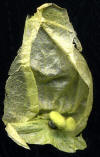|
Salazaria mexicana |
Salazaria mexicana |
|
Salazaria mexicana Shrubland Alliance |
|
|
Salazaria mexicana
|
Salazaria mexicana
|
|
Trees and Shrubs of Kern County (Jan 2013)
Salazaria mexicana Torrey 1859 [Scutellaria mexicana (Torrey) A. J. Patton 1990]. Bladder sage, paper bag bush. Intricately branched shrub arising from a much-branched underground stem-root complex (rhizome) that spreads close to the surface, leafless much of the year, to 1.5 m high and broad, branches often at right angles, ending in a sharp point; flowering after rain, but normally in the spring, flowers small, purple; fruit balloon-like (diclesarium), an inflated calyx enclosing 4 mericarps (“nutlets” in the literature). Characteristic of the yucca and Joshua tree zone on rocky soils, especially along washes, centering in the Mojave Desert, to Utah, Texas, and northern Mexico. Type from “Ravines, Chihuahua, below Presidio del Norte near the Rio Grande.” Bladder sage scrub recognized in MCV2 when ≥2% absolute cover in the shrub canopy and <50% relative cover for other shrubs except Salvia dorrii. Kern Co.: Mojave Desert region to eastern Sierra Nevada, 1,761–1,521 m (CCH). Unlike other members of the mint family, bladder sage lacks the strong mint odor that is typical of the family, and also the sharply angled (square) stems. The related genus Scutellaria differs in the herbaceous habit and in the fruiting calyx, which splits rather than inflates, upon maturity, the fruit regarded as a trymarium (Spjut 1994).
|
|








